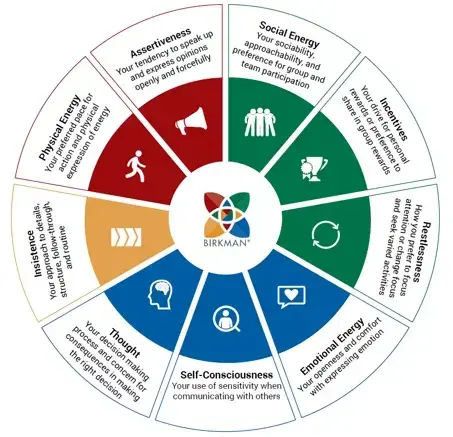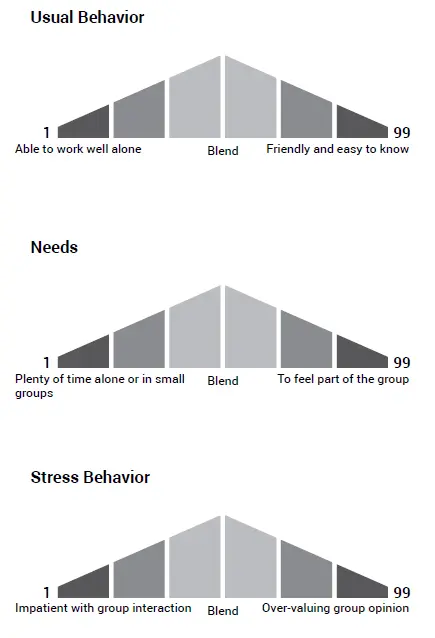Getting started with the Birkman Map
Coaching is critical in any organization, and individual coaching requires an accurate assessment tool like The Birkman Method. Our Signature Report provides the in-depth data needed to make positive change. This blog will discuss pages 15-19 of the Signature Report as it covers our “interpersonal energy” Components: Social Energy, Physical Energy, and Emotional Energy.
Have you read Part 1? If not, check it out here.
Page 15:
On this page, we see an overall view of the nine Birkman behavioral Components, which I frequently term the “meat and potatoes” of Birkman. The Components are the original and powerful backbone of our methodology. These are the relational, motivational, and interpersonal Needs, which constitute the most critical part of our reporting (and they’re our secret sauce).

I appreciate the visual image of a wheel here because it suggests the holistic interconnectivity of all nine advanced behaviors. I tell my dialogue partner that each Component works in sync, and each can, to a greater or lesser degree, impact one another.
Typically, I compare the way the Birkman Components interact to the way the organs of our bodies interact. While a medical student studies the heart and lungs individually, we all know that our bodily organs function together. Unless something is wrong, we don’t think about them but know they’re each functioning together in a way that impacts our overall health.
Similarly, I believe that our underlying motivational Needs are constantly at work as we navigate our relationships, stressors, and careers. When we gain a better understanding of our own Needs and the Needs of those who are close to us, it’s easier to manage ourselves and comprehend others.
Page 16:
Here, we see a summary view of the Component icons. Beneath each icon, there are two numbers. The first number is our visible or Usual side of the trait, along with the second number representing our internal, not so easily seen, Needs. When you point this out, mention the defining difference of Birkman: being able to see how each of us is far more than our outward behavioral appearance. This takes our understanding of self and others to a much deeper level.
Here’s where I like to include the example of a tree. You can see the branches, leaves, and trunk. The Usual behavior is the part of the tree that’s above ground. We can see what kind of a tree it is, but the roots below the surface are hidden. And yet, the roots not only support the tree, but also bring water and nourishment to the rest of the tree. The roots are the unseen Needs that ultimately determine the vitality of the tree. It is the all-important roots that nurture and support the overall health of the tree.
At this point, I like to say that while our Components work together as a unit, for ease of understanding, we’re going to be looking at them one at a time on the following pages.
Page 17:
Social Energy is a convenient way to show the pattern for how we’ll talk about each of the nine Components. Each page has three little mountains (pyramids if you prefer) representing a spectrum from 1% to 99%.
We know from our years of research that people are literally all up and down this spectrum, which is a very good thing for us all. Along with what we love to do (our Interests), this is where our personality diversity comes from. There are no wrong scores, just differing ways we each perceive and re-charge.
Let your partner know that for each of the nine Components, what we’re looking at will always be the same pattern. Usual at the top, Needs in the middle and at the bottom, the possibility of Stress, a frustrated, non-productive reaction. I liken our Stress statements to being like the warning light you may see on your car’s dashboard. It’s probably not the best to keep driving but instead is a signal to pay attention and pullover, a way to alert us to do some maintenance and care.
Tip: If your dialogue partner is concerned that a certain bulleted statement is not accurate for them, let them know you will make a mental note of that question. Reassure them that subsequent pages will bring more depth of understanding and may better clarify their concern, but also let them know that it’s okay to disagree at any time. Use this as an opportunity to ask a few more questions. In most cases, just going ahead with the rest of the Birkman conversation will automatically take care of early questions.
Social Energy is the extent of your independent versus social nature that impacts the way you interact with others and how you are perceived inside the workplace. Below are possible scoring patterns and how to explain them:

A frequently seen pattern for this Component is High Usual and Low Need, meaning those who are friendly and outgoing throughout the workday but later are eager to escape social demands and spend time alone or with just one or two others.
There are also those who describe themselves as Low Usual and Low Need. These are the truly independent types who prefer to avoid group meetings and gatherings as often as possible.
The High Usual and High Need types never seem to tire of being around people. They don’t run out of energy from people but simply from getting physically worn out. The Low Usual with a High Need may appear very reserved or introverted but appreciate group inclusion even when they may still choose to turn it down.
Remember that we are viewing a very wide spectrum for each Component, and there are widely varying intensities for each of these descriptions.
Page 18:
Physical Energy is an especially easy one as it is exactly what it looks like–namely, how much you prefer pace of action and enjoy moving around. When I get to this page, I say that these first three Components conveniently lend themselves to being called “energies,” but in fact, all nine of the Birkman Components are forms of interpersonal energies. As with Social Energy, we can see various combinations of highs and lows. All of these scores are considered to be perfectly “normal” patterns.
This metric is simply an indication of how we prefer to spend or conserve our physical energy levels. I theorize that our higher Physical Energy colleagues use exercise to burn off excess energy before it turns into tension and stress. At the other end of the spectrum, lower Physical Energy types find that exercise helps them create more positive energy. At the end of the day, wherever we land on the Physical Energy spectrum, it’s clear we all need exercise.
Page 19:
Emotional Energy addresses our comfort levels with the open expression of emotions and how intensely we register and demonstrate our feelings. No question that emotions are shared by all humans, and we all have feelings, but we are not all equally comfortable with expressing them in our daily interactions with others. I mention that the lower numbers appreciate objectivity and more logical communication, while the higher numbers are perceived as more demonstrative, enthusiastic, and more likely to express subjective feelings.
When the number is very high, that specific individual may struggle with keeping mood swings and emotional fluctuations under control. Down days can feel especially down and difficult. For each of these three energies, it’s essential to ask how they experience what they see on the page. One thing I know for sure, wherever we land on our behavioral spectrums, there are positive attributes our scores can bring. And there are also the inevitable traps if we lose control and land on the stressor side of our Social, Physical, and Emotional Energies.

In the two blogs to follow, we'll discuss the rest of the Birkman Signature Report.

